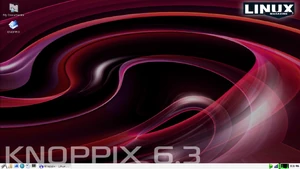
| |
| Founded: |
2000? (edit) |
| Version: | 6.4.4 (edit) |
| Release Date: | February 1, 2011 (edit) |
| Next Release: | Unknown (edit) |
| Platform(s): | i486 (edit) |
| Packaging: | DPKG (edit) |
| Interface(s): | LXDE, GNOME, KDE, Openbox (edit) |
| Derivative of: | Debian (edit) |
| Home Page: | http://www.knopper.net/knoppix/index-en.html (edit) |
Knoppix is a LiveCD distribution of Linux based on Debian. Although there had been other versions of Linux that were able to run as demos and rescue discs before, Klaus Knopper's innovations combined a compressed loopback filesystem driver (developed by Rusty Russell for the Linuxcare Bootable Business Card project), with Debian packaging quality, and with the best hardware detection and automated configuration scripts and programming that had ever been done under Linux.
This has propelled Knoppix to widespread use and spawned a huge number of derivatives.
The compressed filesystem image (originally called the cloop driver) allows a 700 megabyte CD-ROM ISO image to hold approximately 2 gigabytes of software. This allows Klaus to include a full office productivity suite (OpenOffice.org) and a full selection of software.
Newer versions of Knoppix are available on DVD images, which hold 4.7GiB uncompressed, and over 9GiB in the compressed image. They also support a sort of "translucent" filesystem called unionfs which allows a writable RAM disk to be used as an "overlay" to the read-only, compressed filesystem image on the media. This allows the user to fetch and install new and updated software as needed during a single session.
Knoppix is stable and full featured enough to be used a personal workstation even directly from a LiveCD boot. One can keep one's system up for months at a time under typical usage.
Other uses[]
Knoppix also supports features to allow a user to save settings and home directory data to a floppy, USB thumb drive, hard disk, or network fileserver. Also Knoppix can be installed and many people use it as an alternative installer for their Debian systems. (After installation one can simply use the normal Debian apt-get commands to update maintain their system).
- (Note: there are sometimes some minor glitches with "conversion" of Knoppix to mainstream Debian due to some differences in package versioning and patching)
Knoppix also supports an easy and useful "terminal server" mode. Using this one can boot one system with a LiveCD image, run the knoppix-terminal-server script and within a few minutes with almost no expertise, configure the system to act as a boot server for any number of additional (possibly diskless) nodes. The other nodes simply boot over the local network (LAN) using PXE or other boot PROMs in their network cards (NICs). A typical modern PC workstation can easily support a couple dozen client nodes in this configuration (all without touching any of the hard disks on any of the systems involved). (This feature is extremely useful for ad hoc classes and similar uses). The Knoppix terminal server features can also be easily deployed on a PXE/Kickstart server for use as a network rescue image.
External Links[]
| Debian | |
| Major Derivatives: | Knoppix - Ubuntu - SimplyMEPIS |
| Other derivatives: | Damn Small Linux - Kanotix - sidux |
| Notable contributions: | apt |
| [ v - t - e ] | |
